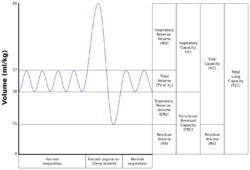Medicine:Vital capacity

Vital capacity (VC) is the maximum amount of air a person can expel from the lungs after a maximum inhalation. It is equal to the sum of inspiratory reserve volume, tidal volume, and expiratory reserve volume. It is approximately equal to Forced Vital Capacity (FVC).[1][2]
A person's vital capacity can be measured by a wet or regular spirometer. In combination with other physiological measurements, the vital capacity can help make a diagnosis of underlying lung disease. Furthermore, the vital capacity is used to determine the severity of respiratory muscle involvement in neuromuscular disease, and can guide treatment decisions in Guillain–Barré syndrome and myasthenic crisis.[citation needed]
A normal adult has a vital capacity between 3 and 5 litres.[3] A human's vital capacity depends on age, sex, height, mass, and possibly ethnicity.[4] However, the dependence on ethnicity is poorly understood or defined, as it was first established by studying black slaves in the 19th century[5] and may be the result of conflation with environmental factors.[6]
Lung volumes and lung capacities refer to the volume of air associated with different phases of the respiratory cycle. Lung volumes are directly measured, whereas lung capacities are inferred from volumes.
Role in diagnosis
The vital capacity can be used to help differentiate causes of lung disease. In restrictive lung disease the vital capacity is decreased. In obstructive lung disease it is usually normal or only slightly decreased.[7]
Estimated vital capacities
| Height | 150–155 cm (4'11"–5'1") | 155–160 cm (5'1"–5'3") | 160–165 cm (5'3"–5'5") | 165–170 cm (5'5"–5'7") | 170–175 cm (5'7"–5'9") | 175–180 cm (5'9"–5'11) |
|---|---|---|---|---|---|---|
| Vital capacity (cm3) | 2900 | 3150 | 3400 | 3720 | 3950 | 4300 |
| Age | 15–25 | 25–35 | 35–45 | 45–55 | 55–65 |
|---|---|---|---|---|---|
| Vital capacity (cm3) | 3425 | 3500 | 3225 | 3050 | 2850 |
Formulas
Vital capacity increases with height and decreases with age. Formulas to estimate vital capacity are:[3]
where is approximate vital capacity in cm3, is age in years, and is height in cm.
References
- ↑ Chhabra, S. K. (January 1998). "Forced Vital Capacity, Slow Vital Capacity, or Inspiratory Vital Capacity: Which Is the Best Measure of Vital Capacity?". Journal of Asthma 35 (4): 361–365. doi:10.3109/02770909809075669. PMID 9669830.
- ↑ "Forced Expiratory Volume and Forced Vital Capacity". https://www.uofmhealth.org/health-library/aa73564.
- ↑ 3.0 3.1 "Vital Capacity". Family Practice Notebook. http://www.fpnotebook.com/Lung/Lab/VtlCpcty.htm.
- ↑ Hutchinson, John (January 1846). "On the Capacity of the Lungs, and on the Respiratory Functions, with a View of Establishing a Precise and Easy Method of Detecting Disease by the Spirometer". Journal of the Royal Society of Medicine MCT-29 (1): 137–252. doi:10.1177/095952874602900113. PMID 20895846.
- ↑ Villarosa, Linda (14 August 2019). "How False Beliefs in Physical Racial Difference Still Live in Medicine Today". The New York Times. https://www.nytimes.com/interactive/2019/08/14/magazine/racial-differences-doctors.html.
- ↑ Braun, Lundy (2015). "Race, ethnicity and lung function: A brief history". Canadian Journal of Respiratory Therapy 51 (4): 99–101. PMID 26566381.
- ↑ "Pulmonary Function Tests". UCSD. https://meded.ucsd.edu/isp/1998/asthma/html/spirexp.html.[|permanent dead link|dead link}}]
- ↑ 8.0 8.1 Pratt, Joseph H. (December 1922). "Long-Continued Observations on the Vital Capacity in Health and Heart Disease". The American Journal of the Medical Sciences 164 (6): 819–831. doi:10.1097/00000441-192212000-00003. ProQuest 125233939. https://zenodo.org/record/1802254.
Further reading
Several studies have been made to measure and predict vital capacity:
- Berglund, E.; Birath, G.; Bjure, J.; Grimby, G.; Kjellmer, I.; Sandqvist, L.; Söderholm, B. (1963). "Spirometric Studies in Normal Subjects I: Forced Expirograms in Subjects Between 7 and 70 Years of Age". Acta Medica Scandinavica 173 (2): 185–192. doi:10.1111/j.0954-6820.1963.tb16520.x. PMID 13970718.
- Birath, G.; Kjellmer, I.; Sandqvist, L. (1963). "Spirometric Studies in Normal Subjects: II. Ventilatory Capacity Tests in Adults". Acta Medica Scandinavica 173 (2): 193–198. doi:10.1111/j.0954-6820.1963.tb16521.x. PMID 13968399.
- Grimby, G.; Sóderholm, B. (1963). "Spirometric Studies in Normal Subjects: III. Static Lung Volumes and Maximum Voluntary Ventilation in Adults with a Note on Physical Fitness". Acta Medica Scandinavica 173 (2): 199–206. doi:10.1111/j.0954-6820.1963.tb16523.x.
- Forche, Günther; Stadlober, Ernst; Harnoncourt, Karl (1988). "Neue spirometrische Bezugswerte für Kinder, Jugendliche und Erwachsene" (in de). Österreichische Ärztezeitung 43 (15;16): 40–42.
- Gulsvik, A.; Tosteson, T.; Bakke, P.; Humerfelt, S.; Weiss, S. T.; Speizer, F. E. (30 November 2001). "Expiratory and inspiratory forced vital capacity and one-second forced volume in asymptomatic never-smokers in Norway: Spirometric standards in Norway". Clinical Physiology 21 (6): 648–660. doi:10.1046/j.1365-2281.2001.00377.x. PMID 11722472.
- Hedenström, H; Malmberg, P; Agarwal, K (November 1985). "Reference values for lung function tests in females. Regression equations with smoking variables". Bulletin Européen de Physiopathologie Respiratoire 21 (6): 551–557. INIST:8470928. OCLC 114155676. PMID 4074961.
- Langhammer, A.; Johnsen, R.; Gulsvik, A.; Holmen, T.L.; Bjermer, L. (1 November 2001). "Forced spirometry reference values for Norwegian adults: the Bronchial Obstruction in Nord-Trøndelag study". European Respiratory Journal 18 (5): 770–779. doi:10.1183/09031936.01.00255301. PMID 11757626.
 |

